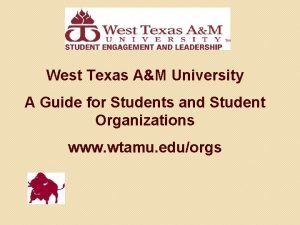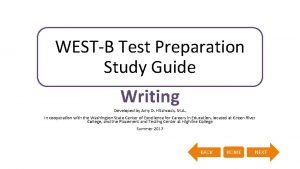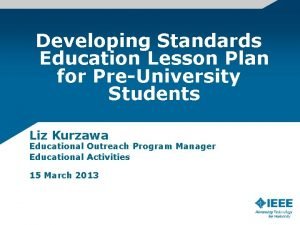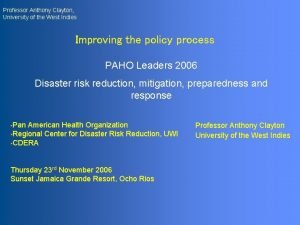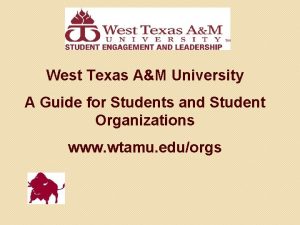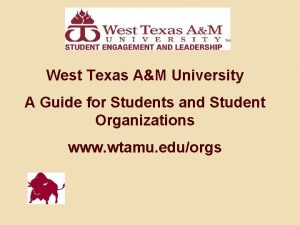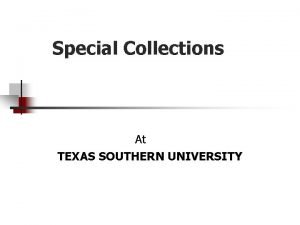West Texas AM University A Guide for Students

























































- Slides: 57

West Texas A&M University A Guide for Students and Student Organizations www. wtamu. edu/orgs

What is Risk Management? �Risk Management is the process of considering the potential and perceived risk involved in student activities. �It includes monitoring organization activities and taking both corrective action and proactive steps to minimize accidental injury and/or loss. �Each organization is required to sign the risk management form after reporting the program content to your organization

High Risk Activities �Hazing �Alcohol and Illegal Drugs �Behavior at Parties and Social Events �Sexual Violence and Harassment �Clery Act �Fire and Other Safety Issues �Travel

Risk Management Concepts �Identify risky behavior and activities �Assess the probability of adverse outcomes �Implement controls to eliminate or reduce the risk �Reassess the activity after the risks have been managed (Source: Georgia Institute of Technology, 2002)

When considering risk concerns for your organizations remember your resources on campus: *Student Engagement & Leadership Office, UPD, and the Risk Management Office

Find strategies you can apply to reduce the severity of the risk and probability that something will go wrong… www. wtamu. edu/risk

RISK MANAGEMENT AND INSURANCE MATRIX Please feel free to speak to or consult with staff in Student Activities to assist in this risk assessment and insurance management process. Step One – List all event activities or concerns. Step Two – Identify risks associated with each activity. Step Three – Use the Matrix to determine the level of risk before applying any Risk Management strategies Step Four – Brainstorm methods to manage risks. See if you can reduce the probability that something will go wrong. Step Five – Submit Risk Management & Insurance Matrix with Activity Proposal to Student Activities. NAME OF EVENT: WTAMU Outdoors LIST SPECIAL ACTIVITIES ASSOCIATED RISKS* SERIOUSNESS PROBABILITY METHOD TO MANAGE RISKS** 1. BB Gun Shooting 2. Climbing Wall 1. 2. 3. 4. 3. Archery 4. ATV’s * Possible risks include: medical emergencies, food poisoning/allergic reactions, damage to University reputation, damage to University property and/or facilities, **Methods to manage risks may include: purchasing special event liability insurance, arranging for security through UPD, traveling with an advisor, rotating drivers SERIOUSNESS I – May result in death. II – May cause severe injury, major property damage, significant financial loss, and/or result in negative publicity for the organization and/or institution. III – May cause minor injury, illness, property damage, financial loss, and/or could result in negative publicity for the organization and/or institution. Probability Seriousness I II IV A B C PROBABILITY D A – Likely to occur immediately or in a short period of time, expected to occur frequently. B – Probably will come in time C – May occur in time. D – Unlikely to occur. IV – Hazard presents a minimal threat to safety, If any special activity score is within the red or yellow the Office of Student Activities must review. The Risk Management & Insurance Matrix must be filed when an Activity health, and well-being of participants. Proposal is require. The form has been provided as an educational tool to help student leaders to develop a process for identifying and discussing potential risk issues. It is intended for use as part of a larger event planning process, and should only serve as a starting point for your discussion on risk management. It is not designed to take the place of a careful review of applicable rules, policies, and laws, or discussion with your advisor. Completion of this form does not imply approval or authorization of your event. For more information on event planning, contact the CORE office.

Decide on an acceptable level of risk for your organization: �Consider modifying activities that have unreasonable risk associated with your organization. �Remember to consider how the activities relate to the mission and purpose or your organization.

What is Hazing? Hazing is a broad term encompassing any action or activity which does not contribute to the positive development of a person; which inflicts or intends to cause physical or mental harm It is defined in the Texas Education Code (Subchapter F. Sec. 37. 151) and the West Texas A&M Code of Student Life.

Hazing Defined. Intentional, knowing, or reckless act directed against a student by one person acting alone or by more than one person occurring on or off University premises that endangers the mental or physical health or safety of a student for the purpose of pledging or associating with, being initiated into, affiliating with, holding office in, seeking and/or maintaining membership in any organization or program whose membership consists of students. Consent and/or acquiescence by a student or students subjected to hazing is not a reasonable defense in a disciplinary proceeding. Hazing includes, but is not limited to: a. Any type of physical brutality, such as whipping, beating, using a harmful substance on the body or similar activity. b. Any type of physical activity that subjects the student to an unreasonable risk of harm or that adversely affects the mental or physical health or safety of a student, such as sleep deprivation, exposure to the elements, confinement in a small space, or calisthenics. c. Any activity involving consumption of a food, liquid, alcoholic beverage, liquor, drug or other substance which subjects a student to an unreasonable risk of harm or which adversely affects the mental or physical health or safety of a student. d. Any activity that intimidates or threatens a student with ostracism, subjects a student to extreme mental stress, shame or humiliation, adversely affects the mental health or dignity of a student, or discourages a student from entering or remaining enrolled at the University, or may reasonably be expected to cause a student to leave the organization or the University rather than submit to acts described above. e. Any activity in which a person solicits, encourages, directs, aids or attempts to aid another in engaging in hazing; intentionally, knowingly or recklessly permits hazing to occur; has firsthand knowledge of the planning of a specific hazing incident which has occurred and knowingly fails to report the incident in writing to the Office of Student Conduct. f. Any activity in which hazing is either condoned or encouraged or any action by an officer or combination of members, pledges, associates or alumni of the organization of committing or assisting in the commission of hazing.

Examples of Hazing If you’re not sure whether or not something happening to you or to someone else is hazing, ask yourself these questions: • Would I feel comfortable participating in this activity if my parents were watching? • Would we get in trouble if a school/college administrator walked by and saw us? • Am I being asked to keep these activities a secret? • Am I doing anything illegal? • Does participation in this activity violate my values or those of this organization? • Is this causing emotional or physical distress or stress to myself or to others? • Am I going to be able to get a job if I have to put a criminal arrest on my application? Don’t Be Confused: If you have to ask if it’s hazing, then it probably is!

Examples of Hazing • • • Signatures Physical Harm Calisthenics Forced Labor Kidnapping Errands for active members Introductions Forced Physical Activity Sleep Deprivation Required alcohol purchase/and or consumption Don’t Be Confused: If you have to ask if it’s hazing, then it probably is!

Why Does Hazing Happen? • We are raised in a culture of hazing • Some forms are personally acceptable • New members expect to be hazed • Advisors may say don’t get caught hazing

Who Is Responsible for Stopping Hazing? You are! If you witness a hazing incident or if you are hazed, you are responsible for making sure you report the incident to the proper authorities. It is your responsibility to report and prevent hazing. If you observe hazing and stand by silently, your silence condones these illegal activities and makes you just as liable as the offenders.

Behavior Intervention Team Caring and Prevention

Mission of the BIT The overall mission of BIT is to review behavioral incidents and ensure a systematic response to students whose behavior may be disruptive/harmful to themselves and/or the WTAMU community support assist student success and in protecting the health, safety and welfare of the students and members of the WTAMU community.

Goals of the BIT Preventing crises Outreach Consultation Referrals Follow-up processes Access to appropriate services Data collection and sharing Centralizing information to observe behavior patterns Providing documented response to distressed students

Tasks of the BIT Review behavior situations where a potential risk of harm to self and/or others exists Consult with administration/faculty/staff Coordinate non-emergency response to violent, threatening, distressed students Develop specific strategies to address behavior Make recommendations for future action

The Team Ø Academic Affairs – Dr. Amy Anderson Ø Student Affairs – Mike Knox, Dr. Christina Cox-Leisinger Ø Student Counseling Services – Orvie Nix Ø University Police Department - Chief Shawn Burns Ø Residential Living – Cindy Spencer Ø Academic Advising – Rebekah Bachman Ø Health Integration Specialist – Dayna Schertler Ø Student Disability Services – Paul Fenstermaker

How to Make a BIT Referral: Visit the BITeam website and submit referral on-line wtamu. edu/BITeam

Alcohol, Illegal Drugs, and Penalties: (also refer to Code of Student Life and the Campus Security Reportavailable online at www. wtamu. edu)

Alcohol, Illegal Drugs and Penalties Public intoxication – Occurs to the degree that a person may endanger himself/herself or others due to mental and physical impairment. An officer is not required to give you a breath test or a field sobriety test to show that you are publicly intoxicated. Minor in Possession - MIP - A person under 21 in possession of an alcoholic beverage is in violation. Fine starting at $250. 00 Plus suspension of Drivers license Minor in Consumption – MIC – could involve just taking one sip of alcohol to violate the law.

Alcohol, Illegal Drugs and Penalties It’s illegal to use someone else’s identification or a fake ID, especially to buy alcohol. You can be arrested and taken to jail for this offense! Purchase / Furnish Alcohol to a Minor Fines: Up to $4, 000. 00 and Up to 1 yr. in Jail Furnishing alcohol to a minor or providing a place for a minor to consume alcohol is a serious Class A misdemeanor and is under the jurisdiction of the County Court. A Class A misdemeanor is one step below a felony. Remember if you are having a party at your house or apartment, you are responsible. If one minor is found drinking at your party you are in violation.

Alcohol, Illegal Drugs and Penalties Driving Under the Influence - Minor A minor is DUI when having any detectable amount of alcohol while operating a motor vehicle. The 1 st offense is a Class C misdemeanor Fines: Confinement in jail for up to 180 days, a fine up to $500 and driver’s license suspension 90 days to 1 year, 20 -40 hours of community service Driving While Intoxicated A person is Driving While Intoxicated when having a blood alcohol concentration of 0. 08 or more while operating a motor vehicle. The 1 st offense is a Class B misdemeanor Fines: Confinement in jail for up to 180 days, a fine up to $2, 000 and driver’s license suspension 90 days to 1 year The 2 nd offense is a Class A misdemeanor Fines: Confinement in jail a minimum of 30 days & up to one year, a fine not to exceed $4, 000 and driver’s license suspension 180 days to 2 years The 3 rd offense is a third degree felony Fines: 2 to 10 years in prison, a fine not to exceed $10, 000, an driver’s license suspension 180 days to 2 years (Fines do not include court cost and lawyer fees)

Alcohol, Illegal Drugs and Penalties Possession of Drugs The possession of a usable quantity of Marijuana (2 oz. or less), Synthetics (K-2, Spice, bath salts), THC oils and edibles is an offense under state law. This offense is a Class B Misdemeanor Fine: Confinement in jail for up to 180 days and a fine up to $2, 000 Heroin, Cocaine, Methamphetamine, Methadone, Opiates, etc. Possession of any of these drugs can carry a range of felony punishments.

Alcohol, Illegal Drugs and Penalties Methods of Control �Check IDs and use bracelets to identify those over 21. �Serve non-alcoholic beverages. �Limit the start and end times. For example, limit parties to four hours. �Maintain control of all alcoholic beverages present. �Do not allow impaired individuals to drive. �Seek medical assistance as needed and do not leave the person alone.

Behavior at Parties and Social Events *Remember that there alternative forms of transportation available if you’ve had too much to drink… Call a cab or call a friend

Behavior at Parties Can Our Organization Be Held Responsible for an Individual’s Behavior? • YES! • It can depend on number of members attending BUT most importantly… • You assume responsibility if the activity is related to the organization. Organizations may be held responsible when… • acts of individual members are directly related to the student organization's activities. • a member is violating local, state, or federal law or University regulations and other members fail to discourage the activity. Remember … in addition to the group being held responsible, members, officers, and even advisors may be held individually responsible for an individual members actions.

Burglary Property Awareness (Did you know. . . )? � Your vehicle or dorm room could be burglarized in less time than it takes to read this slide… � Most commonly stolen items include: - Wallets, purses, backpacks - Cell phones - Radar detectors - Portable electronics - Small personal items � Lock your door, even if you are only going to the bathroom or leaving momentarily. Lock your vehicles and roll up windows! � If your wallet/purse is stolen, you could become a victim again, this time of fraud and identity theft. � It takes time to straighten out problems with creditors and your credit may be damaged (remember to alert the 3 major credit bureaus). � If you happen to walk up on your vehicle while a crime is in progress, report it and avoid a violent confrontation (Your life is not negotiable for property!)

In Case of Campus Emergency: • Broadcast e-mails • Local Media Contacts • Building & Floor Coordinators • Enroll in the WT Emergency Notification System called Buff-Alert, which will e-mail and text your designated phone number in case of a campus emergency. **You can also Text crime tips to 79516**

PSAP (#911)-Public Safety Answering Point IMPORTANT INFORMATION ABOUT 911 CALLS : The UPD Communications Center allows the general public access to a "real" person 24 hours per day. Telecommunicators are trained to handle emergency calls and utilize the computerized dispatch center. The Communications Center’s computerized systems allow telecommunicators to communicate with other police agencies all over the nation and in 150 foreign countries through access of the Texas Law Enforcement Telecommunications System, National Crime Information Computer and Texas Crime Information Computer. To reach the telecommunications center, call (806) 651 -2300.

With regard to campus safety: “If you see something, say something…”

Emergency Operations Plan �Available at wtamu. edu

Sexual Violence Sexual Harassment

Sexual Violence-Sexual Harassment � Sexual Violence – physical sexual acts perpetrated against a person’s will or when a person is incapable of giving consent. A number of different acts falls into the category of sexual violence, including sexual assault, sexual battery, sexual abuse, sexual coercion, and sexual exploitation. � Sexual Harassment is a form of sex discrimination. Unwelcome sexual advances, requests for sexual favors and other verbal, nonverbal or physical conduct of a sexual nature constitute sexual harassment when this conduct is so severe, persistent or pervasive that it explicitly or implicitly affects an individual's employment, unreasonably interferes with an individual's work or educational performance, or creates an intimidating or hostile work or educational environment. Unwelcome means that an individual did not request or invite it and considers the conduct to be undesirable or offensive. Submission to the conduct or failure to complain does not always mean that the conduct was welcome. Sexual harassment may be quid pro quo (“this for that”) or may constitute a hostile environment. Sexual harassment includes non - consensual sexual contact, sexual assault, sexual exploitation, and stalking, dating violence, and domestic violence when based on sex. Federal law prohibits sexual harassment of college students whether the harasser is an employee, another student or a third party.

Reporting Sexual Violence and Harassment � West Texas A&M University provides equal opportunity to all employees, students, applicants for employment, and the public regardless of race, color, religion, sex, national origin, disability, age, genetic information or veteran status. West Texas A&M University will promptly and thoroughly investigate all complaints of discrimination, sexual harassment, and related retaliation in accordance with applicable federal and state laws, Texas A&M University System Policy 08. 01 and Regulation 08. 01, and university rules and/or procedures. � Any member of the campus community or public who witness, are subjected to, or are informed about incidents of discrimination, sexual harassment, and/or related retaliation involving faculty, staff, or students should contact Becky Lopez, 2501 4 th Avenue, Canyon, Texas, (806) 651 -3199.

Sexual Violence-Sexual Harassment If you have been Sexually Assaulted Find a safe environment � Preserve the evidence of attack � Report the attack as soon as possible � Seek medical attention � Find out about your resources: Contact WT’s Victim’s Assistance Coordinator at #651 -2307 � Helping Victims Let victims make decisions � Listen with patience � Active Listening � Provide victims with information and referrals �

Sexual Violence-Sexual Harassment How to Reduce the Risk of Sexual Assault �Educate Yourself �Look out for friends �Stay in Groups �Never be alone with someone you don’t know �Decide what your limits are and communicate them clearly �Do not assume anything �TRUST YOUR INSTINCTS �Never leave drinks unattended

Watch Your Drink!!! �Keep an eye on your friends’ drinks �Date rape drugs can happen �If you think you’ve consumed a drink containing a date rape drug: - Call 911 - Get to a hospital quickly

The Clery Act

Jeanne Clery 19 year old Freshman Lehigh University She was a good student, well-liked, athletic, and had an infectious laugh. o In 1986 she was sexually assaulted, strangled, murdered o Perpetrator was a student that entered the hall with the intent to burglarize rooms o 181 situations of auto-locking doors being propped open reported from her Hall o 38 violent crimes reported on the Lehigh campus in prior three years, not reported to the community o Resident hall room left unlocked for roommate o Congress enacted the Clery Act in 1990 Why we have the Clery Act:

Clery Act Federal Mandated Responsibilities �Educate students in primary prevention, ongoing prevention and awareness of sexual assault, stalking, dating and domestic violence �Be an active bystander �Know how to reduce your risk �Review Campus Security and Fire Safety Report www. wtamu. edu/reports �Report crime associated with your organization for review to be included in annual security report

Campus Security Authority Function Criminal Offenses to Report �A CSA is to report to � the official or office designated by the institution to collect crime report information, such as the campus police, those allegations of Clery Act crimes that he or she concludes were made in good faith Murder/Non-negligent Manslaughter � Negligent Manslaughter � Sex Assault ◦ ◦ Rape Fondling Incest Statutory Rape Robbery � Aggravated Assault � Burglary � Motor Vehicle Theft � Arson � Stalking � Dating Violence � Domestic Violence �

Contact for additional training and information and to report crime (non-emergency) associated with your organization or during travel with your organization. MERI LYN ODELL CLERY COORDINATOR modell@wtamu. edu 806 -651 -2307

Fire and Life Safety

In case of fire, the best way out may not be the way in… In a fire, seconds count. It is difficult to see through the thick, toxic smoke. People panic and rush to the only way they know out—the entrance. The entrance may not be the best (or quickest) way out, however. When you enter a building, any building, plan an exit strategy. Notice at least two exits you could use in the event of a fire. Get out alive…. www. haveanexitstrategy. com

www. haveanexitstrategy. com

Fire and Life Safety �Events may have inherent physical risks that require contingency plans including: ◦ Fire Safety – WT #651 -2134 ◦ Inclement Weather – WT Weather Line #651 -2010 ◦ Campus Emergency – University Police #911

Fire and Life Safety General Fire/Life Safety Guidelines for Events: • First priority is to ensure safety of attendees • Have some method of accounting for attendees • Organizations should have Emergency contact numbers for Fire, Police, & Ambulance posted near common phones. • Prior to any event plan & provide for all facilities: • Evacuation routes • Shelter • Know specific location descriptions to direct emergency services. • The possession of firearms or explosive devices of any kind is forbidden.

Fire and Life Safety Fire – evacuate building and do not allow anyone to re-enter a building until cleared by the proper authority. There are several common causes of accidental college fires: • Careless smoking • Unattended candles, incense, perfume burners • Cooking • Overloaded extension cords and power outlets • Leaves and debris located near buildings • Improper use of surge protectors • Unattended cooking grills

Food Safety: �The group hosting an event is responsible for all food safety preparation and service. Individuals within the group are expected to follow standard food safety and hygiene practices for food served or sold. � Safety Standards (including proper hand washing, hand sanitizer, and paper towels): ◦ Monitor cooking thermometer temperatures: • Hot Dogs/Hamburgers 160˚F; Chicken 170˚F • Cold foods to be held at 41˚F ◦ ◦ No cross contamination of cooked and uncooked foods Sanitize all Utensils Portable Fire Extinguishers for Barbecue Grilling Disposable gloves for handled food

Travel https: //apps. wtamu. edu/studenttravel/ www. wtamu. edu/orgs https: //wtaccess. wtamu. edu/travel/

Travel General Requirements �If driving a University vehicle, you must be a WT employee and approved by providing your Driver’s License for a record check and you must attend a session of WT’s driver safety training. �Must have proof of personal automobile insurance and registration as required by state law, if personal vehicle to be used. (Plus Personal Vehicle Authorization Form) �Safe Driver Training available with Safety Office #806 -651 -2134.

Travel General Requirements, cont. �All travel MUST be routed through the electronic system and if not, travel privileges will be revoked. �Additional training is available through the Office of Student Engagement & Leadership.

Travel Things to Think About �Anticipate or prepare for bad weather and emergency expenses associated with travel �Preventable Risks (for example, transportation in open beds of trucks should be avoided) �Length of trip and number of available drivers

Risk Management Training Next Steps Within 45 days following completion training, the officers or advisors receiving the training must: � Report the program content at a meeting of the full membership of the recognized student organization. � Submit to the Office of Student Engagement and Leadership a signed statement saying the report was made. � Adopt a risk management policy for the organization. 56

Questions? For all policies refer to: The Campus Organizations Handbook and the Code of Student Life; both available at the Office of Student Affairs (JBK) or online at www. wtamu. edu
 Why was/were rizal called the champion of filipino students
Why was/were rizal called the champion of filipino students West north west wind direction
West north west wind direction Name of the wind series
Name of the wind series Waar is het noord oosten
Waar is het noord oosten East is east and west is west
East is east and west is west Old west vs new west
Old west vs new west West texas am
West texas am West b writing practice test
West b writing practice test El paso texas travel guide
El paso texas travel guide Texas health steps check up
Texas health steps check up Dependent and independent variables
Dependent and independent variables Matthias benzer
Matthias benzer Aristotle university of thessaloniki international students
Aristotle university of thessaloniki international students Pre university students age
Pre university students age Gef wvu
Gef wvu Ucw uap
Ucw uap Ixl palm beach lakes
Ixl palm beach lakes Ewu bd
Ewu bd Professor anthony clayton
Professor anthony clayton University of west hungary
University of west hungary University of west georgia colors
University of west georgia colors Fspos
Fspos Typiska drag för en novell
Typiska drag för en novell Nationell inriktning för artificiell intelligens
Nationell inriktning för artificiell intelligens Returpilarna
Returpilarna Varför kallas perioden 1918-1939 för mellankrigstiden?
Varför kallas perioden 1918-1939 för mellankrigstiden? En lathund för arbete med kontinuitetshantering
En lathund för arbete med kontinuitetshantering Särskild löneskatt för pensionskostnader
Särskild löneskatt för pensionskostnader Personlig tidbok för yrkesförare
Personlig tidbok för yrkesförare A gastrica
A gastrica Densitet vatten
Densitet vatten Datorkunskap för nybörjare
Datorkunskap för nybörjare Stig kerman
Stig kerman Hur skriver man en tes
Hur skriver man en tes Delegerande ledarskap
Delegerande ledarskap Nyckelkompetenser för livslångt lärande
Nyckelkompetenser för livslångt lärande Påbyggnader för flakfordon
Påbyggnader för flakfordon Formel för lufttryck
Formel för lufttryck Publik sektor
Publik sektor Kyssande vind analys
Kyssande vind analys Presentera för publik crossboss
Presentera för publik crossboss Jiddisch
Jiddisch Vem räknas som jude
Vem räknas som jude Treserva lathund
Treserva lathund Epiteltyper
Epiteltyper Bästa kameran för astrofoto
Bästa kameran för astrofoto Cks
Cks Lågenergihus nyproduktion
Lågenergihus nyproduktion Mat för unga idrottare
Mat för unga idrottare Verktyg för automatisering av utbetalningar
Verktyg för automatisering av utbetalningar Rutin för avvikelsehantering
Rutin för avvikelsehantering Smärtskolan kunskap för livet
Smärtskolan kunskap för livet Ministerstyre för och nackdelar
Ministerstyre för och nackdelar Tack för att ni har lyssnat
Tack för att ni har lyssnat Referat mall
Referat mall Redogör för vad psykologi är
Redogör för vad psykologi är Matematisk modellering eksempel
Matematisk modellering eksempel Atmosfr
Atmosfr






